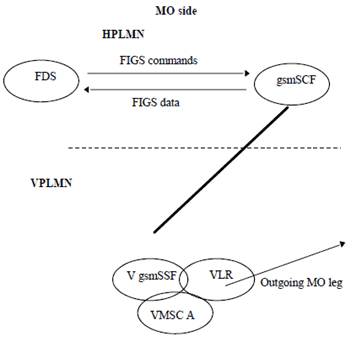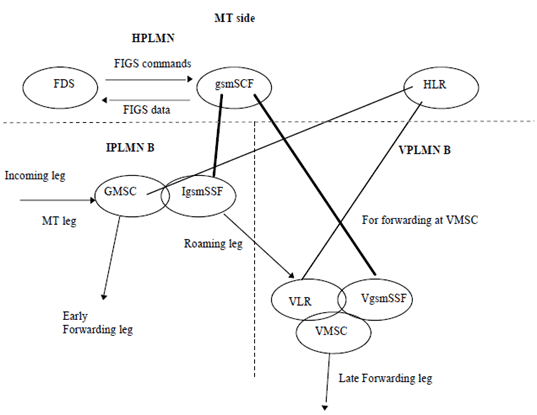Content for TS 23.031 Word version: 18.0.0
4 FIGS Monitoring Levels
5 FIGS Level 1: Accelerated TAP Records
5.1 Method of FIGS Setting
5.2 Information Flows
6 FIGS and CAMEL Architecture for FIGS Levels 2 and 3
7 FIGS Levels 2 and 3
7.1 Method of FIGS Setting
7.2 Information Flows
4 FIGS Monitoring Levels p. 6
There are three levels of monitoring of subscriber activities using FIGS.
Level 1
an accelerated TAP procedure associated with a mechanism such as Hot Billing is implemented in the MSC of the VPLMN.
Level 2
CAMEL is used to gather information, but only at the beginning and the end of the call.
Level 3
CAMEL provides full information on subscriber activities, as defined in 3GPP TS 42.031, i.e. call start and end times, and partial call records. Notification of the invocation of Explicit Call Transfer, Call Deflection, Call Forwarding, Call Hold and Multi Party Service is also given.
5 FIGS Level 1: Accelerated TAP Records p. 7
5.1 Method of FIGS Setting p. 7
A PLMN shall request that a VPLMN monitor a designated subscriber using FIGS level 1 by setting a Hot Billing flag in the subscriber data stored in the HLR of the HPLMN. This data is drawn down by the VPLMN when the subscriber first registers in the VPLMN.
If the HPLMN wishes to begin monitoring of a subscriber using FIGS Level 1 when the subscriber is already registered in the VPLMN, it resets the subscriber data in the VPLMN using command Insert Subscriber Data.
5.2 Information Flows p. 7
If a subscriber in a VPLMN is set in the subscriber categories to be monitored using FIGS Level 1 the VMSC shall process and return the TAP records for that subscriber in accordance with the guidelines given in current and future version of TAP.
6 FIGS and CAMEL Architecture for FIGS Levels 2 and 3 p. 7
FIGS provides the following information flows to the HPLMN, with respect to roaming subscribers monitored by FIGS Levels 2 and 3.
FIGS Level 2:
call start and end times (both MO, MT and forwarded calls). (At CAMEL Phase 1 the gsmSSF will not put a timestamp on messages. The arrival times of messages at the gsmSCF will be used for call start and end times.)
FIGS Level 3:
As for level 2 with the addition of:
partial call information (accumulated duration of call still in progress) (CAMEL Phase only);
notification of the invocation of ECT, CD and MPTY, CF and call hold (CAMEL Phase 2 only).
Further phases of CAMEL will provide the functionality to check the IMEI of the ME used by a CAMEL subscriber. Other information required by 3GPP TS 42.031, annex A, that is not provided by CAMEL Phase 1 and CAMEL Phase 2, may also be provided by further phases of CAMEL.
The architecture of the services provided by FIGS Levels 2 and 3 is given in the diagrams below. Thick lines indicate possible CAMEL monitoring/control relationships.


Early call forwarding can be performed if the subscriber has set Unconditional Call Forward or the HLR has determined, before the call is extended to VPLMN B, that the B subscriber is not reachable. In all other cases the call must be extended to the VMSC.
The information flows required by FIGS levels 2 and 3 can be provided by the information flows on the CAP interfaces between the gsmSCF and the gsmSSF in the interrogating and visiting networks.
The interface between the gsmSCF and the Fraud Detection System (FDS) is non-standard.
7 FIGS Levels 2 and 3 p. 9
7.1 Method of FIGS Setting p. 9
A PLMN shall request that a VPLMN monitor a designated subscriber using FIGS levels 2 or 3 by setting the O-CSI, T-CSI and SS-CSI (level 3 only) flags in the subscriber data stored in the HLR of the HPLMN. This data is drawn down by the VPLMN when the subscriber first registers in the VPLMN.
If the HPLMN wishes to begin monitoring of a subscriber using FIGS Level 2 or 3 when the subscriber is already registered in the VPLMN, it resets the subscriber data in the VPLMN using command Insert Subscriber Data.
7.2 Information Flows p. 9
FIGS Levels 2 and 3 will be treated together in this section but it should be remembered that partial call records and SS notification invocation is not available with FIGS Level 2.
Each item of call data required by FIGS will be considered in turn and the information flows within CAMEL which provide this data given.
Text applies to the implementation of FIGS functionality using both Phases 1 and 2, unless otherwise stated.
MO and MT calls will be treated together. If a message or DP is named as O/T_Answer, for instance, this means that if the call is MO, the relevant DP is O_answer, and that if the call is MT, the relevant DP is T_answer.
Diagrams showing the information flows for FIGS levels 2 and 3 are given in Annex A.
7.2.1 Mobile Originated and Mobile Terminated Calls p. 9
7.2.1.1 Call Start Time p. 9
Information regarding a call attempt can be obtained from the InitialDP message sent from the gsmSSF to the gsmSCF. This message is sent after a control relationship for the call has been set up between the gsmSSF and gsmSCF. This message will provide notification to the FDS that a FIGS monitored subscriber has made a call attempt, or that an attempt is being made to call a FIGS monitored subscriber.
CAMEL Phase 1
The call, however, has not been connected at the time of the InitialDP message. The gsmSCF must therefore arm DP O/T_answer, so that the gsmSSF will inform the gsmSCF when the called party answers/connects. The gsmSCF arms the DP with message Request_Report_BCSM_Event sent to the gsmSSF.
If the called party answers, the gsmSSF sends Event_Report_BCSM (Notify and Continue) to gsmSCF. This message provides notification to the FDS that the attempted call has begun. The gsmSCF must then arm DP O/T_Disconnect, so that the gsmSSF will notify the gsmSCF when the call ends.
If the called party does not answer, the gsmSSF terminates the relationship for the call with the gsmSCF. It does this using message "ABORT". This message provides notification to the FDS that the call attempted did not connect.
CAMEL Phase 2
The call, however, has not been connected at the time of the InitialDP message. The gsmSCF must therefore arm DP O/T_Answer, so that the gsmSSF will inform the gsmSCF when the called party answers/connects. The following DP's (with trigger events given) must also be armed so that the gsmSCF will be informed if the trigger event occurs:
O_Route_Select_Failure
For the purposes of FIGS, these DP's need only be armed for notification (N).
The gsmSCF arms all these DPs with a single message Request_Report_BCSM_Event, sent to the gsmSSF.
If the trigger event for any of O_Route_Select_Failure, O/T_Busy, O/T_No_Answer, O/T_Not_Reachable occurs then the gsmSCF is informed by the gsmSSF of the failure of the call attempt with Event_Report_BCSM, enclosing the relevant cause.
If the called party answers, the gsmSSF sends message Event_Report_BCSM to the gsmSCF. This message provides notification to the FDS of the start of a call by a FIGS monitored subscriber. The gsmSCF must then arm DP O/T_Disconnect, so that the gsmSSF will notify the gsmSCF when the call ends.
(call establishment fails, MO calls only)
O/T_Busy
(called party is busy)
O/T_No_Answer
(no answer from called party)
O/T_Abandon
(calling party abandons the call before the called party has answered)
O/T_Not_Reachable
(called party is not reachable)
7.2.1.2 Partial Call Records p. 10
This functionality is available with CAMEL Phase 2 only.
Using the "Apply Charging" process within CAMEL Phase 2, the gsmSCF can control the duration of a call. The gsmSCF authorises the gsmSSF to allow the call to proceed continue for a certain time. At the conclusion of this time period, the gsmSSF seeks further instructions from the gsmSCF. The gsmSCF can, at this point, authorise the call to continue for another time period (which may be different to the first) or may instruct the gsmSSF to terminate the call.
With regard to FIGS, this functionality can be used to generate partial call records for the gsmSCF, as follows:
After the gsmSCF has received the InitialDP message from the gsmSSF, the gsmSCF sends message Apply_Charging to the gsmSSF, containing parameter "Tcs", the "call segment" duration. The gsmSSF will then send message Apply_Charging_Report to the gsmSCF after Tcs seconds. This message c
ontains the duration of the call since the start of charging The gsmSCF may then instruct the gsmSSF to allow the call to continue for another Tcs seconds and this sequence of events continues until the call is released. When the call is released, Apply_Charging_Report is sent to the gsmSCF.
The gsmSCF can therefore define how often it is to receive partial call records on a per subscriber, per call basis, and can change how often the partial call records are received during a call
7.2.1.3 Call End Time p. 10
When either of the calling or called parties releases the call, the O/T-Disconnect DP is triggered and message Event_Report_BCSM is sent to the gsmSCF. This message provides notification to the FDS of the call end.
7.2.2 Forwarded Call p. 11
7.2.2.1 Call Start Time p. 11
The forwarded leg "from" the called party to the forwarded to number is considered as an MO call, originated by the called subscriber, as well as an MT call for the called subscriber. Two separate CAMEL dialogues will therefore be set up.
The CAMEL process for the terminating leg will follow subclause 7.1 as an MT call and the CAMEL process for the "originating" (forwarded) leg will follow subclause 7.1 as an MO call.
7.2.2.2 Partial Call Records p. 11
As for subclause 7.1.2.
7.2.2.3 Call End Time p. 11
As for subclause 7.1.3.
7.2.3 Supplementary Service Invocation p. 11
This functionality is available with CAMEL Phase 2 only.
From CAMEL Phase 2 (GSM 03.78 Release 97), subclause 8.11:
"At the invocation of any of the services ECT, CD and MPTY the MSC/VLR checks whether the criteria for sending a notification is fulfilled, i.e. whether the subscriber is provisioned with the SS-CSI and the particular invoked supplementary service is marked in the SS-CSI. If this is the case a notification is sent to the gsmSCF given by the gsmSCF address contained in the SS-CSI. The processing of the particular SS invocation is not suspended. If the notification criteria is not fulfilled the processing of the particular supplementary service continues unchanged and no notification is sent.
The sending of the notification is independent of call related CAMEL processing, i.e. processing indicated by O/T-CSI."